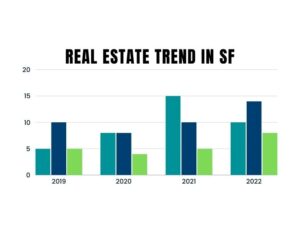San Francisco, the City by the Bay, is renowned for its iconic landmarks, vibrant culture, and thriving tech industry. However, its allure comes with a hefty price tag, especially when it comes to housing. Renting in San Francisco presents a unique set of challenges and opportunities, and understanding the market is crucial for newcomers and seasoned renters alike.
1. Unveiling the Rent Landscape: Average Prices by Apartment Size
As of February 2024, San Francisco boasts an average rent of $3,934 per month according to RentCafe. This number can vary significantly based on several factors, including:
- Apartment size: Studios average around $2,850, one-bedrooms reach $3,500, two-bedrooms climb to $4,500, and three-bedrooms soar to $5,800 on average.
- Neighborhood: Rents fluctuate significantly across various districts. More affluent areas like Pacific Heights and Marina District see significantly higher rents compared to the outer districts like Sunset and Richmond.
- Building amenities: Luxury buildings with amenities like gyms, doorman services, and in-unit laundry will naturally command higher rents compared to older, simpler buildings.
2. Finding Your Niche: Best Neighborhoods for Renters
San Francisco offers a diverse range of neighborhoods, each catering to distinct preferences and budgets. Here’s a glimpse into some popular options:
- For young professionals: Mission District and SoMa pulsate with a youthful energy, offering a vibrant nightlife, trendy restaurants, and a central location.
- For families: Outer Richmond and Sunset District provide a more relaxed atmosphere with access to green spaces, family-friendly amenities, and slightly lower rents.
- For culture enthusiasts: Chinatown and North Beach offer a rich cultural tapestry, with historical landmarks, authentic cuisine, and a strong sense of community.
Remember, the “best” neighborhood depends on individual priorities and preferences. Consider factors like commute time, desired amenities, and proximity to desired attractions when making your choice.
3. Renting 101: Tips for Newcomers to San Francisco
Navigating the competitive San Francisco rental market can be daunting, but with preparation and a few insider tips, you can find your perfect place:
- Start your search early: Competition is fierce, so begin your search 4-6 weeks before your desired move-in date.
- Prepare your application package: Gather documents like proof of income, credit report, and references beforehand to expedite the process.
- Be flexible: Be open to different neighborhoods, apartment sizes, and move-in dates to increase your chances of finding a suitable option.
- Beware of scams: Research landlords and properties before signing anything. Never pay deposits or rent without a signed lease agreement.
4. Renting vs. Buying: Weighing the Options
The decision between renting and buying in San Francisco is a significant one. Here’s a breakdown of some key considerations:
Renting:
- Pros: Offers flexibility, lower upfront costs, and minimal maintenance responsibility.
- Cons: Subject to rent increases, lack of long-term financial gain, and potential landlord restrictions.
Buying:
- Pros: Builds long-term wealth through equity accumulation, offers greater control and customization, and potential tax benefits.
- Cons: Requires a substantial down payment, comes with ongoing maintenance costs, and carries the risk of fluctuating property values.
Ultimately, the choice depends on individual financial circumstances, long-term plans, and risk tolerance.
5. Knowing Your Rights: Rental Laws and Regulations in San Francisco
As a tenant in San Francisco, you are protected by various laws and regulations, including:
- Rent control: Applicable to buildings built before 1979, it limits annual rent increases and provides eviction protections.
- Tenant rights: Tenants have the right to safe and habitable living conditions, proper notice for rent increases and evictions, and security deposit return within specific timeframes.
Familiarizing yourself with these regulations empowers you to navigate the rental landscape confidently and enforce your rights as a tenant.
Conclusion
Renting in San Francisco can be a rewarding experience, offering access to a vibrant city and a diverse range of neighborhoods. By understanding the average rent prices, exploring different neighborhoods, equipping yourself with renting tips, and being aware of the differences between renting and buying, you can make informed decisions and find a place that aligns with your needs and budget. Remember, knowledge and preparation are key to navigating the competitive San Francisco rental market successfully.












